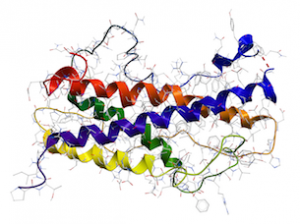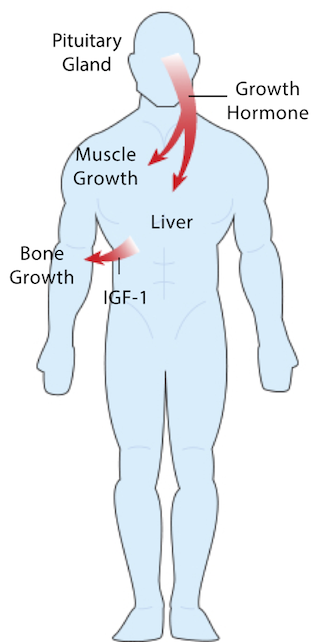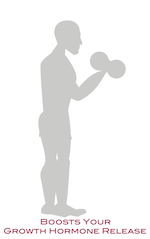Where did interest in human growth hormone (HGH) begin? In 1990, Dr. Daniel Rudman and his colleagues published an article in the New England Journal of Medicine on human growth hormone therapy in men.1 The article suggested that HGH therapy for older men could produce positive body changes. The study showed that the male participants lost fat and gained muscle.
After this publication, interest in and use of HGH therapy exploded. A multitude of anti-aging clinics opened and proclaimed this therapy to be a remedy for the aging process. Companies began selling HGH supplements. As a result human growth hormone therapy as an anti-aging therapy is one of the most popular health-related Internet searches.
Despite its popularity as a “magic bullet” for aging, human growth hormone therapy has never actually been shown to slow, stop, or reverse the aging process. Nor has it been shown to increase lifespan. Also, the sale or use of HGH for anti-aging is illegal in the US. Needless to say, human growth hormone therapy for healthy adults is a highly controversial subject. Opponents demonize its use in healthy adults, while proponents extol its benefits in counteracting the aging process. Read on to learn more about this therapy, including side effects and additional concerns.
HGH (Human Growth Hormone) Therapy
The following articles attempt to provide a comprehensive, yet easy to understand explanation of human growth hormone therapy. All of the information provided is based on current scientific evidence, not conjecture. Years from now, the generally accepted opinion on this therapy may change; however, at this time we are limited in our knowledge by the information at hand. First, learn what is HGH. Then, learn about GH levels and aging. Then, learn about known benefits and side effects of therapy. Finally, learn about the overall safety of HGH therapy.
♦ What is HGH
Human growth hormone is an anabolic hormone, meaning it induces growth. It is primarily released in the first half of sleep by the pituitary gland (a small endocrine gland located at the base of the brain). It stimulates growth in most body tissues, primarily due to increases in cell number rather than size.2 This includes skeletal muscle mass. It also stimulates the breakdown of fat tissue, usually producing noticeable fat loss during treatment.2
Although it induces muscle growth, much like testosterone, it is also different than testosterone in many ways. Primarily, it is a peptide, not a single molecule like testosterone. Specifically, HGH is composed of a string of 191 molecules known as amino acids. This complexity makes outside synthesis difficult. Because the synthesis is difficult, it is far more expensive than testosterone. Replacement therapy for GH deficiency costs around $10,000 per year. Additionally, since it is a peptide, injectable HGH is the only viable form. All other forms, such as oral or inhalable forms, would be broken down by gastric acid in the stomach into its individual amino acid components. Thus, these forms would not produce any changes. It is important to state this fact again, oral pills and inhalable sprays are completely ineffective. For more information, see EMG’s What Is HGH Article.
♦ Growth Hormone and Aging
HGH is secreted at its highest levels during puberty when it promotes the growth of tissues. After puberty, GH levels drop rather dramatically. By late adulthood, levels are typically far less than half the levels during early adulthood.3,4 Since both aging and GH decline are associated with decreased muscle and increased fat, it has been hypothesized by some that this decline at least in part causes unwanted effects associated with aging. This association is one reason why there is considerable interest in human growth hormone therapy.
♦ HGH Benefits
As mentioned above, human growth hormone induces muscle growth and promotes fat breakdown. It should come as no surprise then that therapy on otherwise healthy adults has produced favorable changes to body composition.5-17 These favorable changes include increased muscle mass and decreased fat mass. Studies show that such therapy increased lean body mass by an average of approximately five lbs. over a 26-week evaluation period. At the same time, fat mass decreased by an average of approximately five lbs. over the same evaluation period. As a result, study participants generally weighed the same at the end of the study trial. However, their body composition changed for the better. See EMG’s HGH Benefits Article for more information.
In lieu of any side effects or other concerns, these positive changes are no doubt attractive. Unfortunately, these same studies show significant side effects.
♦ HGH Side Effects
Human growth hormone therapy produces several, relatively common adverse effects.5-19 The first group of side effects includes effects related to salt and water retention. Side effects in this group include edema (soft tissue swelling caused by fluid retention) and hypertension (high blood pressure).
The second group of side effects include effects related to nerve and joint pain. Side effects in this group include joint pain (commonly in the elbows, wrists, hips, knees, and ankles) and carpal tunnel syndrome. Carpal tunnel causes numbness, tingling, weakness, or muscle damage in the hand and fingers.
The third group of side effects include effects related to benign tissue growth. Side effects in this group include gynecomastia. Gynecomastia is the enlargement of male breast tissue. This enlargement leads to aesthetically unappealing deposits of fat under the nipples.
The fourth and final group of side effects include effects related to metabolic dysfunction. Side effects in this group include impaired glucose tolerance, which increases the risk of diabetes. HGH may impair glucose tolerance because it tends to cause hyperinsulinemia, a state of elevated blood insulin levels. These elevated levels may lead to insulin resistance and subsequently to outright diabetes. See HGH Side Effects for more information.
♦ Is HGH Safe: Other Concerns
Human growth hormone is FDA approved for overt deficiency due pituitary tumors. It is also approved for muscle-wasting from HIV/AIDS. However, it is not approved for anti-aging, nor is it considered safe by the vast majority of the medical community for this purpose.
In addition to common adverse side effects, other concerns also exist. The following list provides the main concerns with HGH therapy.
- First, the long-term safety and efficacy of human growth hormone therapy is unknown. Most currently available studies are limited both in duration (less than six months) and participation. Therefore, it is difficult to assess the long-term safety and efficacy of such a treatment.
- Second, the link between human growth hormone therapy and cancer is unknown. Because HGH induces tissue growth, serious concern exists over this potential connection. To date, no data indicates that such therapy increases the chances of cancer.20-22 In fact, the Pfizer international metabolic database (KIMS) does not show higher than expected risk of cancer in people treated with GH therapy when compared with the risk of cancer in the general population. This study, however, utilizes short follow-up periods and looks at individuals with overt GH deficiency.
- Third, diagnosing, dosing, and monitoring guidelines have not been fully established for such a therapy. No set of best practice guidelines has been established for HGH therapy in men with age-related GH decreases but without overt deficiency.
♦ How to Increase Growth Hormone Naturally
While combating age-related declines in GH secretion with HGH therapy is not recommended, certain healthy lifestyle habits can help combat this decline naturally. First and foremost, both weight training and aerobic exercise stimulate GH secretion. This increase benefits your muscles, bones, and connective tissue. Exercise also extends the action of GH on these target tissues.
For weight training, the larger the muscle groups exercised and the higher the intensity, the greater the GH release. For aerobic exercise, the more vigorous the exercise, the greater the GH release. While exercise increases GH release, it is essential to rest adequately between workouts. Too much exercise can actually decrease GH release.
In addition to exercise, good sleep also maximizes GH secretion. As mentioned above, HGH is primarily releases during the first half of sleep. Anything that interferes with sleep interferes with GH secretion.23-24 Common culprits include alcohol, caffeine, sleep apnea, or certain medications.
To avoid suppressing GH release, avoid stress and putting on excess weight. Stress, particularly chronic stress, reduces GH secretion. Additionally, obesity is associated with lower GH production. On average, obese men produce less human growth hormone than non-obese men.3,25 For more information, see EMG’s How to Increase Growth Hormone.
External Resources: WebMD: Human Growth Hormone (HGH)
Updated: May 13, 2015
1. Rudman D, Feller AG, Nagraj HS, et al. Effects of human growth hormone in men over 60 years old. N Engl J Med. Jul 1990; 323 (1): 1-6.
2. Llewllyn, W. Anabolics. 6th Edition. Body of Science. 2007. 501-503.
3. Iranmanesh A, Lizarralde G, Veldhuis JD. Age and relative adiposity are specific negative determinants of the frequency and amplitude of (GH) secretory bursts and the half-life of endogenous GH in healthy men. J Clin Endocrinol Metab. Nov 1991; 73 (5): 1081-1088.
4. O’Connor KO, Stevens TE, Blackman MR. GH and aging. In: Juul A, Jorgenson JOL, eds. GH in Adults. Cambridge, UK: Cambridge University Press; 1996.
5. Liu H, Bravata DM, Olkin I, et al. Systematic review: the safety and efficacy of GH in the healthy elderly. Ann Intern Med. Jan 2007; 146 (2): 104-115.
6. Yuen K, Wareham N, Frystyk J, et al. Short-term low-dose GH administration in subjects with impaired glucose tolerance and the metabolic syndrome: effects on beta-cell function and post-load glucose tolerance. Eur J Endocrinol. Jul 2004; 151 (1): 39-45.
7. Blackman MR, Sorkin JD, Münzer T, et al. GH and sex steroid administration in healthy aged women and men: a randomized controlled trial. JAMA. Nov 2002; 288 (18): 2282-2292.
8. Lange KH, Andersen JL, Beyer N, et al. GH administration changes myosin heavy chain isoforms in skeletal muscle but does not augment muscle strength or hypertrophy, either alone or combined with resistance exercise training in healthy elderly men. J Clin Endocrinol Metab. Feb 2002; 87 (2): 513-523.
9. Christmas C, O’Connor KG, Harman SM, et al. GH and sex steroid effects on bone metabolism and bone mineral density in healthy aged women and men. J Gerontol A Biol Sci Med Sci. Jan 2002; 57 (1): M12-18.
10. Münzer T, Harman SM, Hees P, et al. Effects of GH and/or sex steroid administration on abdominal subcutaneous and visceral fat in healthy aged women and men. J Clin Endocrinol Metab. Aug 2001; 86 (8): 3604-3610.
11. Lange KH, Isaksson F, Rasmussen MH, Juul A, Bülow J, Kjaer M. GH administration and discontinuation in healthy elderly men: effects on body composition, GH-related serum markers, resting heart rate and resting oxygen uptake. Clin Endocrinol (Oxf). Jul 2001; 55 (1): 77-86.
12. Svensson J, Bengtsson BA, Taskinen MR, Wiklund O, Johannsson G. A nine-month, placebo-controlled study of the effects of treatment on lipoproteins and LDL size in abdominally obese men. Growth Horm IGF Res. Jun 2000; 10 (3): 118-126.
13. Karlsson C, Stenlöf K, Johannsson G, et al. Effects of human growth hormone treatment on the leptin system and on energy expenditure in abdominally obese men. Eur J Endocrinol. Apr 1998; 138 (4): 408-414.
14. Johannsson G, Mårin P, Lönn L, et al. GH treatment of abdominally obese men reduces abdominal fat mass, improves glucose and lipoprotein metabolism, and reduces diastolic blood pressure. J Clin Endocrinol Metab. Mar 1997; 82 (3): 727-734.
15. Papadakis MA, Grady D, Black D, et al. Human growth hormone therapy in healthy older men improves body composition but not functional ability. Ann Intern Med. Apr 1996; 124 (8): 708-716.
16. Cohn L, Feller AG, Draper MW, Rudman IW, Rudman D. Carpal tunnel syndrome and gynaecomastia during GH treatment of elderly men with low circulating IGF-I concentrations. Clin Endocrinol (Oxf). Oct 1993; 39 (4): 417-425.
17. Rudman D, Feller AG, Cohn L, Shetty KR, Rudman IW, Draper MW. Effects of human growth hormone on body composition in elderly men. Horm Res. 1991; 36 Suppl 1: 73-81.
18. Rosenfalck AM, Fisker S, Hilsted J, et al. The effect of the deterioration of insulin sensitivity on beta-cell function in growth-hormone-deficient adults following 4-month GH replacement therapy. Growth Horm IGF Res. Apr 1999; 9 (2): 96-105.
19. Johnston DG, Al-Shoumer KA, Chrisoulidou A, Kousta E, Beshyah S, Robinson S. Long-term effects of human growth hormone therapy on intermediary metabolism and insulin sensitivity in hypopituitary adults. J Endocrinol Invest. 1999; 22 (5 Suppl): 37-40.
20. Harman SM, Blackman MR. Use of human growth hormone for prevention or treatment of effects of aging. J Gerontol A Biol Sci Med Sci. Jul 2004;59 (7): 652-658.
21. Clayton PE, Banerjee I, Murray PG, Renehan AG. GH, the insulin-like growth factor axis, insulin and cancer risk. Nat Rev Endocrinol. Jan 2011; 7 (1): 11-24.
22. Svensson J, Bengtsson BA. Is HGH Safe? Safety aspects of GH replacement. Eur J Endocrinol. Nov 2009; 161 Suppl 1: S65-74.
23. Ekman AC, Vakkuri O, Ekman M, Leppäluoto J, Ruokonen A, Knip M. Ethanol decreases nocturnal plasma levels of thyrotropin and growth hormone but not those of thyroid hormones or prolactin in man. J Clin Endocrinol Metab. Jul 1996; 81 (7): 2627-2632.
24. Roehrs T, Roth T. Sleep, sleepiness, and alcohol use. Alcohol Res Health. 2001; 25 (2): 101-109.
25. Williams T, Berelowitz M, Joffe SN, et al. Impaired growth hormone responses to GHRF in obesity. A pituitary defect reversed with weight reduction. N Engl J Med. Nov 1984; 311 (22): 1403-1407.










